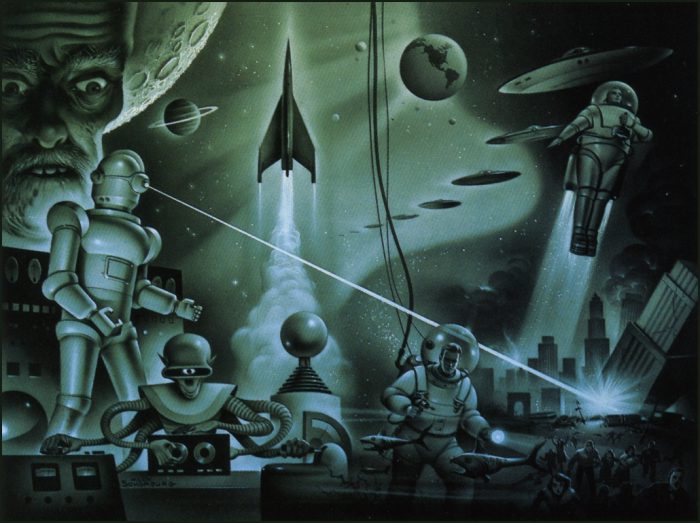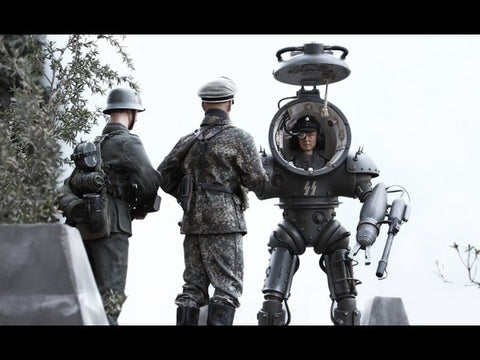
THE MAJOR CHANGE IN SCI-FI AFTER WORLD WAR II
Share
HAS SCIENCE FICTION CHANGED OVER TIME?
Sci-fi is quite possibly of the most flexible class in the movies, and watching its all advancement across the years uncovers a few fascinating patterns. Sci-fi was perhaps the earliest class to arise in film history, and it has changed emphatically in the 100+ years that it's been around.
WANT TO KNOW WHAT HAS CHANGED?
After The Second Great War, distributers generally deserted the pulps for soft cover books and soft cover like "digests." At that point, notwithstanding, sci-fi had roused such enthusiastic dedication that it moved easily into little specialty presses. Two new summary magazines specifically. The Magazine of Imagination and Sci-fi (1949-) and World Sci-fi (1950-80) — flourished. Sci-fi likewise filled in well-known regard after the coming of the nuclear bomb (1945) and the sendoff of Sputnik (1957).

Photo Credit: Britannica
1. SCIENCE FICTION DIGESTS:
The meaning of a review is a gathering of data or a magazine or periodical with synopses of the news or other data.
Under the article direction of the new SF digests, American sci-fi of the 1950s turned out to be more refined, urbane, and satiric, with crude techno philia fading for more regarding human sciences- based hypothesis about social orders and societies. Many books (and film variations) from the ten years were overflowing with Cold Conflict-instigated dread and distrustfulness.
THE MOST AGENT NOVEL:
Maybe the most agent novel is Walter M. Mill operator's A Canticle for Leibowitz (1960; first serialized, 1955-57), which depicts the post-atomic holocaust endeavors of a Catholic strict request to safeguard information. Another work, Intrusion of the Body Snatchers (1955; films 1956 and 1978), in a reasonable instance of socialist suspicion, relates the narrative of normal individuals being supplanted by clones who work as a feature of an aggregate body.

Photo Credit: Sci-fi Vox Digest
3. SCI-FI MOVIES:
Sci-fi movies of the period, with a couple of remarkable special cases —, for example, The Day the Earth Stopped (1951), The Conflict of the Universes (1953), and Prohibited Planet (1956) — would in general be economically created, adolescent, predictable movies about outsider attacks and colossal freaks. (It was during this period that the Japanese delivered various Godzilla motion pictures.) In the class' fiction, nonetheless, the American threesome of Robert Heinlein, Isaac Asimov, and Beam Bradbury — later joined by Briton Arthur C. Clarke — appreciated overall acclaim and unparalleled prevalence during the 1940s, '50s, and mid -60s. Anglophone sci-fi was predominant during the 1950s and '60s, however writers from different nations — like the Clean dream author Stanisław Lem and the artistic Italian Italo Calvino, with his fantascienza — additionally progressed the class.

Photo Credit: Sci-fi Movies
4. THE CHANGE IN THE AIR:
The change was additionally in the air in Soviet Russia. The political and social defrost that happened during the standard of Nikita Khrushchev during the 1950s, when limitations on Russian craftsmen were loose, and the Russian-drove sunrise of the space age caused an emotional upsurge in Soviet sci-fi, including works by Ivan Yefremov, Kir Bulychev, and the eminent doyens of Russian-language sci-fi, the siblings Arkady and Boris Strugatsky. A comparative flood in Chinese sci-fi went with the finish of the Social Upset (1966-76). As a matter of fact, toward the beginning of the 21st 100 years, China's fundamental sci-fi magazine guaranteed a readership of 500,000, pre dominating the flow of any sci-fi distributed in the West.
In England and the US, the publication polemics of Michael Moorcock (related for a long time with New Universes and its collections) and Harlan Ellison (Perilous Dreams [1967] and Once more, Risky Dreams [1972]) drove a defiant new wave development that worked with the class' move in new headings. Donning nonconformist negligence for restrictions (especially about ethics and sexuality), an interest in mind-changing medications and Eastern religions, and interest in trial scholarly styles, the development pushed the limits of conventional sci-fi until the class was practically unrecognizable. Most cutting-edge experimentalism had evaporated by the last part of the 1970s, however, by then the New Wave had boundlessly extended the subgenre of "delicate" sci-fi. ("Delicate" SF is normally more worried about investigating social parts of the not-so-distant future and of "inward space," while "hard" sci-fi highlights innovation for the good of innovation.)
5. SCI-FI IN PREVIOUS TIMES:
Rather than prior many years, customary sci-fi of the last part of the 1960s and mid-'70s arrived at exceptional ubiquity on TV and in film. American SF TV series, for example, Star Trip (1966-69; established by Quality Roddenberry), may have prepared filmmakers and crowds the same for film variations of "serious" sci-fi. Fahrenheit 451 (1966), 2001: A Space Odyssey (1968), and Charly (1968) — given works by Bradbury, Clarke, and Daniel Keyes, separately — procured basic commendation and pulled in a developing number of chiefs and entertainers to the class. Assuming any uncertainty stayed about the business feasibility of SF film, the blockbuster motion pictures Star Wars (1977), Close Experiences of the Third Kind (1977), and E.T.: The Extra-Earthbound (1982) demonstrated that sci-fi had at long last moved past its drive-in B-film status. U.S. film industry receipts for sci-fi, dream, and thrillers hopped from 5% in 1971 to almost 50% by 1982; albeit the offer fell to some degree in the resulting years, sci-fi kept on being one of the main Hollywood film designs.
6. THERE IS MORE TO KNOW ABOUT:
Ridley Scott's film Cutting edge Sprinter (1982), depends on Philip K. Dick's Do Androids Long for Electric Sheep? (1968), prefigured the 1980s peculiarity known as cyberpunk. It joined interest in robotics (the study of correspondence and control hypothesis, particularly as to the human sensory system and mind) with a "punk," or distanced, social cognizance, in this way merging components of delicate and hard sci-fi. William Gibson in Neuromancer (1984) begat the word the internet to depict a PC intervened virtual world in which people stopped their minds. Different works of this subgenre incorporate John Shirley's City Come A-Walkin' (1980), Bruce Real's Schismatrix (1985), and Lewis Shiner's Abandoned Urban communities of the Heart (1988). The dangerous development of the PC business during the 1990s and the new discussions for communicating distance introduced by the Web gave cyberpunk composing a supporting feeling of prompt significance.
7. SCIENCE FICTION MOVIES OR PLAYS:
The staggering idea of sci-fi thematics played emphatically for Hollywood's specialized potential benefits over rival films in Europe, Japan, Hong Kong, and Mumbai (then Bombay). After the 1970s, the American SF film with its cutting-edge embellishments became sci-fi public face. Sci-fi movies like The Eliminator series (1984, 1991, 2003, 2009, 2015), the Outsider series (1979, 1986, 1992, 1997), and the Jurassic Park series (1993, 1997, 2001, 2015) became significant cash workers around the world.

Photo Credit: Sci-Fi Play
8. THE SCI-FI MOVIES ON THE TOPIC OF WORLD WAR 2:
The following is a fragmented rundown of sci-fi, dream, and loathsomeness including movies or miniseries on the topic of The Second Great War.
- King of the Zombies
- Black Dragons
- Thunder Rock
- Tarzan Triumphs
- Shock Waves
- Death Ship
- The Final Countdown
- Oasis of the Zombies
- Zone Troopers
- In a Glass Cage
- the Rocketeer
- he Devil's Arithmetic
CONCLUSION
Sci-fi became well-known and famous after The Second Great War. Soon after The Second Great War, new, more youthful essayists started composing sci-fi, which had a consistent readership after the conflict.
Subscribe to our Newsletter at Telbises for more.
